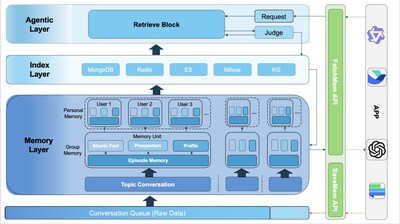Outlook on the Digital Pathology Global Market to 2027: Featuring 3Dhistech, Apollo Enterprise Imaging, Clinisys and Corista Among Others
Press Releases
Feb 06, 2023
DUBLIN, Feb. 6, 2023 /PRNewswire/ — The “Digital Pathology: Technologies and Global Markets” report has been added to ResearchAndMarkets.com’s offering.

This report includes forecasted trends and sales in the digital pathology markets through 2027. Key market participants, extensive product segments, supporting technologies, trends and market dynamics, competitive intelligence, and regional trends are discussed.
Companies Mentioned
- 3Dhistech Ltd.
- Apollo Enterprise Imaging Corp.
- Clinisys
- Corista
- F. Hoffmann-La Roche Ltd.
- Huron Technologies International Inc.
- Indica Labs Inc.
- Inspirata Inc.
- Leica Biosystems Inc.
- Ligolab Information Systems LLC
- Mikroscan Technologies Inc.
- Nikon Instruments Inc.
- Visiopharm
- Xifin
There is a detailed discussion on market dynamics and the level of impact, key geographies and respective trends, and competitive scenarios that will form the base data for qualitative analysis and market estimates.
The digital pathology and telepathology market have been analyzed for the four main geographic regions: North America, Europe, Asia-Pacific, and the Rest of the World (RoW).
This report will provide details with respect to the conventional process of pathology laboratories, but it will specifically exclude the scope of market analysis for conventional path-lab devices (e.g., conventional microscopes, slides).
The connectivity and network issues discussed in the report will be specific to data and information generated from pathology labs and that regarding specific diagnosis; but it will exclude general hospital-based mHealth issues. Telepathology covered in the report is limited to diagnostic, research and development (R&D), and education and training applications. It excludes the scope of telemedicine at a larger level.
The radiology industry has recently witnessed radical digital innovation similar to that which was experienced by the lab medicine and pathology segments. Digital intrusion has made handheld X-ray films redundant and instead transformed them into computer screen images.
These computer images have now become the new industry norm. Significant strategic investments have been made by many service providers in the digital pathology segment to facilitate better education, research and diagnosis. Advancement in internet technology has enabled real-time access to video-stream images in hospitals and labs.
A pathology system’s features and benefits differ from one company to the next. Each company’s system displays vary in scan speed, proprietary software technology and support backups. The key to succeed in this market is to have a setup with a system design for pathologists that is practitioner-centric. A collaborative approach is necessary to successfully meet end-user needs.
The FDA is intensely precise during its approval processes for diagnostic image scanning. Outcomes from these trials will shape digital diagnosis in the future. At the center of the scrutiny is the question of effectiveness and accuracy of digital diagnosis over microscopic diagnosis, and whether pathologists are able to make the same diagnoses from images. HER2 image analysis is one subset of analysis that the FDA has already approved.
Artificial intelligence (AI) in pathology is having a considerable impact on the quality and speed of diagnosis. The accuracy drills down to subtle features that the best-trained human eyes could never see. AI tools will also be able to offer recommendations for treatment in a matter of seconds in the near future.
A number of machine-learning-based diagnostic tools have entered the clinical marketplace, making it easier to spot wrist fractures, diabetic eye disease and signs of stroke with little or no human input. These applications are automating tasks otherwise performed by diagnosticians, bringing more analytical precision and accuracy to the process.
Report Includes
- 52 data tables and 32 additional tables
- An up-to-date overview and analysis of the global markets for digital pathology technologies
- Analyses of the global market trends, with historic market revenue data for 2020 and 2021, estimates for 2022, and projections of compound annual growth rates (CAGRs) through 2027
- Highlights of the upcoming market opportunities for the digital pathology market, industry specific growth driving factors, and areas of focus to forecast this market into various segments and sub-segments
- Estimation of the actual market size and market forecast for digital pathology in value (USD millions) terms, and their corresponding market share analysis by system, type, application, end-user, and geographic region
- In-depth information (facts and figures) concerning major market dynamics, technology updates, new products and applications, and COVID-19 impact on the market for digital pathology
- Coverage of the technological, economic, and business considerations of the global market for digital pathology, with analyses and market forecasts through 2027
- Updated information on key mergers and acquisition deals, agreements, collaborations and product launches within the digital pathology industry
- A relevant patent analysis
- Analysis of the company competitive landscape for digital pathology market, and company value share analysis based on segmental revenues and key financial performance
- Profile descriptions of the leading global companies, including CliniSys, F. Hoffmann-La Roche Ltd., Leica Biosystems Inc., Nikon Instruments Inc., and XIFIN Inc.
Key Topics Covered:
Chapter 1 Introduction
Chapter 2 Executive Summary
Chapter 3 Market Overview
3.1 Current Trends in Digital Pathology
3.1.1 Collaborations to Develop Better Solutions
3.1.2 Innovations to Surge Market Growth
3.1.3 Cloud Computing to Enhance Healthcare Delivery Systems
3.1.4 Digital and Computational Pathology
3.2 Telepathology and Digital Pathology Market Definition, Evolution and Integration
3.2.1 Key Markets for Digital Telepathology
3.3 Conventional Process Versus Digital Pathology and Cost Works
3.4 Image Analysis and Its Importance in Key Research Areas
3.5 Digital Pathology in Clinical Trials
3.6 Digital Pathology: Electronic Health Records, Electronic Medical Records and Other Information Systems
3.7 Regulatory Environment
3.8 Technology Trends
3.9 Digital Pathology: Developed Versus Developing Economies
3.10 the Middle East and African Digital Pathology Market Trends
3.11 Market Intelligence
3.12 Technology Transition: Digital Pathology Components to Integrated Systems
3.13 Digital Market Segment Overview
3.14 Agreements and Collaborations to Enhance Presence in Imaging Applications
3.15 U.S. As the Base for Digital Pathology System Innovation
3.16 Strategic Conclusions
3.17 Case Studies
3.17.1 Case Study 1: Digital Pathology Enabling Critical Diagnosis
3.17.2 Case Study 2: Initiatives and Examples of Telepathology Deployment in Developing Economies
3.17.3 Case Study 3: Digital Pathology’s Role in Cost Savings Among Big Pharma Companies
3.17.4 Case Study 4: Digital Pathology in Resource-Poor Settings
3.17.5 Case Study 5: Health Evaluation Centers in Vietnam — Business Model of Medical Support of Foreign Countries With Wsi Telepathology
3.17.6 Case Study 6: Complete Digital Pathology for Primary Diagnosis, Two Years On: the Experience at Granada 3.17.1 University Hospitals, Spain
3.17.7 Case Study 7: Telepathology in Mongolia
3.17.8 Case Study 8: the Prostate Cancer Image Epidemiology Project: Toward Model-Based Histopathology, Sweden
3.17.9 Case Study 9: a Financial Projection for Digital Pathology Implementation at a Large, Integrated Healthcare Organization
3.18 Market Dynamics
3.18.1 Drivers
3.18.2 Restraints
3.18.3 Challenges and Opportunities
3.19 Impact of the Covid-19 Pandemic
3.19.1 Introduction
3.19.2 Impact on Digital Pathology Market
Chapter 4 Digital Pathology System Market
4.1 Challenges in Implementing Ai
4.2 Digital Pathology Devices Market
4.2.1 Virtual Microscopy and Virtual Slides
4.2.2 Digital Cameras
4.2.3 Robotic Microscopes
4.2.4 Image Sensors
4.2.5 Scanners
4.3 Digital Pathology Analytics Market
4.3.1 Visualization and Image Analysis Platforms
4.3.2 Digital Pathology Information Management Systems
4.4 Digital Pathology Storage Market
4.4.1 Vendor-Neutral Archive
4.5 Communication Platform Market
4.5.1 Web-Based or Cloud-Based Communication Platforms in Digital Pathology
4.5.2 Internet of Medical Things (Iomt) Enabling Real-Time Monitoring and Action
4.5.3 Increased Adoption of Electronic Healthcare Records (Ehrs)
4.5.4 Artificial Intelligence (Ai) on the Cloud to Facilitate Better Diagnostics
4.5.5 Telemedicine Bringing Healthcare to Rural and Remote Areas
4.5.6 Digital Twins Enable Safe Testing Environments
4.6 Telepathology Systems
4.6.1 Key Advantages of Telepathology Systems
4.6.2 Static Image-Based Systems
4.6.3 Hybrid Telepathology Systems
4.6.4 Real-Time Telepathology Imaging Systems
Chapter 5 in Vitro and Other Diagnostic Devices in the Digital Pathology Market
5.1 Automated Hematology Analyzers and Blood Cell Counters
5.1.1 Hematology Analyzer Components and Mechanics
5.1.2 Hematology Instrument Software
5.1.3 Hematology Instrumentation from the Manufacturer’s Perspective
5.1.4 Advanced Hematology Analyzer Model Market
5.1.5 Standard Hematology Analyzer Model Market
5.1.6 Digital Cell Counter Features
5.1.7 Current Products and Features
5.2 Digital Chromosome Analyzers
5.3 Fluorescence in Situ Hybridization Enumeration Systems
5.4 Digital Urine Sediment Analyzers
5.5 Immunohistochemistry Image Analysis Applications
5.6 Digital Cytopathology
5.7 Digital Polymerase Chain Reaction
5.7.1 Digital Polymerase Chain Reaction Applications
5.7.2 Digital Polymerase Chain Reaction Advantages
5.7.3 Real-Time Versus Traditional Versus Digital Polymerase Chain Reaction
5.8 Signet Cell Detection
5.9 Digital Holographic Microscopy
Chapter 6 Digital Pathology Market by Type
6.1 Anatomical Pathology
6.1.1 Key Considerations for Integrating Digital Pathology Systems With Anatomy Pathology Laboratory Information Systems
6.1.2 Genetic Pathology
6.2 Hematology and Clinical Pathology
6.3 Immunopathology
6.4 Chemical Pathology
6.5 Forensic Pathology
6.6 Microbiology
Chapter 7 Digital Pathology Market by Application
7.1 Disease Diagnosis
7.2 Drug Discovery and Drug Development
7.2.1 Digital Image Uses
7.3 Research and Development
Chapter 8 End-User Market
8.1 Biotech and Pharma Companies
8.2 Hospitals and Diagnostic Centers
8.3 Academic Centers and Others
Chapter 9 Regional Market Analysis
9.1 North America
9.2 Europe
9.2.1 Case Study: Implementation Issues for Virtual Microscopy in Europe
9.3 Asia-Pacific
9.3.1 China
9.3.2 India
9.4 Rest of the World (Row)
Chapter 10 Competitive Landscape
10.1 New Product Development
10.2 Other Key Strategies
Chapter 11 Patent Analysis
11.1 U.S. Patent Analysis
11.2 European Patent Analysis
11.3 Japan Patent Analysis
11.4 List of Patents
Chapter 12 Company Profiles
For more information about this report visit https://www.researchandmarkets.com/r/r9ljkt
Media Contact:
Research and Markets
Laura Wood, Senior Manager
[email protected]
For E.S.T Office Hours Call +1-917-300-0470
For U.S./CAN Toll Free Call +1-800-526-8630
For GMT Office Hours Call +353-1-416-8900
U.S. Fax: 646-607-1907
Fax (outside U.S.): +353-1-481-1716
Logo: https://mma.prnewswire.com/media/539438/Research_and_Markets_Logo.jpg
![]() View original content:https://www.prnewswire.com/news-releases/outlook-on-the-digital-pathology-global-market-to-2027-featuring-3dhistech-apollo-enterprise-imaging-clinisys-and-corista-among-others-301739352.html
View original content:https://www.prnewswire.com/news-releases/outlook-on-the-digital-pathology-global-market-to-2027-featuring-3dhistech-apollo-enterprise-imaging-clinisys-and-corista-among-others-301739352.html
SOURCE Research and Markets



